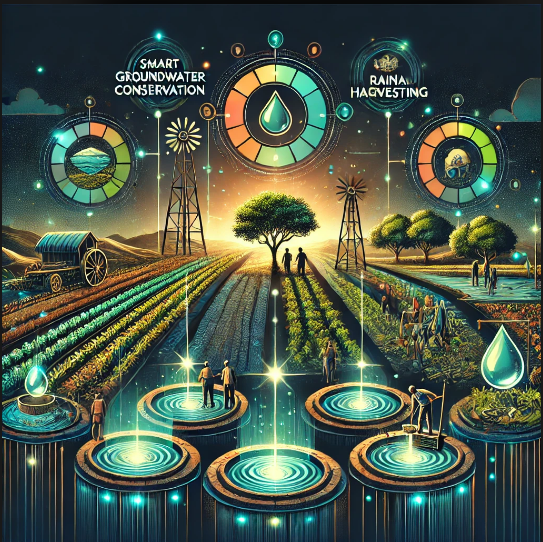Introduction Water scarcity and depleting groundwater levels have become pressing concerns in India, threatening agricultural productivity and sustainable development. Recognizing this challenge, the Government of India launched the Atal Bhujal Yojana (ATAL JAL) on December 25, 2019, commemorating the birth anniversary of former Prime Minister Atal Bihari Vajpayee. The scheme primarily focuses on ensuring sustainable groundwater management through community participation. With a financial outlay of ₹6,000 crore, the initiative is being implemented across seven water-stressed states—Gujarat, Haryana, Karnataka, Madhya Pradesh, Maharashtra, Rajasthan, and Uttar Pradesh—to curb groundwater depletion and promote conservation efforts. This essay explores the objectives, key components, and overall impact of Atal Bhujal Yojana in addressing India’s water crisis.
Objectives of Atal Bhujal Yojana
Atal Bhujal Yojana is designed to promote groundwater conservation, optimize water usage, and ensure long-term water security. The core objectives include:
1. Strengthening Institutional Frameworks
One of the primary goals is to enhance the institutional mechanisms governing groundwater management. Strengthening local bodies, government agencies, and water user associations is crucial for effective planning and implementation of conservation efforts.
2. Encouraging Community Participation
A significant focus of ATAL JAL is to empower local communities by involving them in decision-making processes related to water conservation. Gram Panchayats and farmers play a central role in the preparation and execution of Water Security Plans (WSPs).
3. Incentivizing States for Effective Groundwater Management
The scheme introduces a performance-based incentive system to motivate states to adopt sustainable groundwater practices. This includes effective implementation of demand-side measures, promoting micro-irrigation, and reducing excessive groundwater withdrawal.
4. Promoting Water Use Efficiency
By advocating the use of modern irrigation techniques such as drip irrigation, sprinkler systems, and crop diversification, the scheme aims to reduce water wastage in agriculture, which is the largest consumer of groundwater.
5. Enhancing Data Monitoring and Management
ATAL JAL focuses on strengthening the groundwater monitoring network by installing new observation wells and leveraging technology for real-time data collection. This ensures accurate assessment and better planning of groundwater resources.
Key Components of Atal Bhujal Yojana
The scheme is structured around two major components:
1. Institutional Strengthening and Capacity Building
This component focuses on building the capacity of local institutions by enhancing technical skills, improving infrastructure, and ensuring better coordination between stakeholders.
2. Incentive-Based Performance Monitoring
States receive financial incentives based on their performance in implementing sustainable groundwater management practices. This system ensures accountability and encourages states to actively participate in conservation efforts.
Implementation and Funding
The ₹6,000 crore budget for the scheme is shared equally between the Government of India and the World Bank. The entire fund is provided to states as a grant. The implementation period extends from 2020-21 to 2024-25, covering 8,562 Gram Panchayats across 80 districts in the selected states.
States are encouraged to integrate Atal Bhujal Yojana with existing water conservation programs, ensuring maximum impact through convergence with Jal Jeevan Mission, MGNREGA, and PMKSY.
Impact of Atal Bhujal Yojana
The implementation of ATAL JAL is expected to yield numerous benefits in groundwater conservation, sustainable agriculture, and community awareness.
1. Sustainable Groundwater Management
By reducing excessive groundwater extraction and promoting conservation techniques, ATAL JAL contributes to long-term sustainability.
2. Strengthening Rural Livelihoods
Since agriculture heavily depends on groundwater, better water availability ensures higher crop yields and improved incomes for farmers. The scheme also promotes crop diversification, reducing dependence on water-intensive crops like rice and sugarcane.
3. Improved Drinking Water Security
ATAL JAL supports source sustainability for drinking water schemes, ensuring a reliable water supply in rural areas under the Jal Jeevan Mission.
4. Community Awareness and Behavioral Change
Active community involvement fosters awareness about responsible water use, leading to long-term behavioral changes among farmers and households.
5. Enhanced Data-Driven Decision Making
With improved groundwater monitoring and real-time data collection, policymakers can make informed decisions to mitigate water crises effectively.
Challenges and the Way Forward
While ATAL JAL is a transformative initiative, several challenges must be addressed for its success:
1. Ensuring Active Community Participation
Sustained engagement of local communities is essential, requiring continuous awareness programs and training sessions.
2. Integrating Technological Innovations
Expanding the use of IoT-based groundwater monitoring systems, AI-driven predictive analysis, and GIS mapping can enhance the efficiency of groundwater conservation efforts.
3. Strengthening Policy Implementation
To ensure accountability, strict groundwater extraction regulations must be enforced, preventing over-exploitation by industries and large-scale farming operations.
4. Improving Coordination Between Departments
Seamless integration with other government schemes and effective inter-departmental coordination can enhance efficiency and maximize impact.
Conclusion
Atal Bhujal Yojana is a pioneering step towards sustainable water management in India. By focusing on community participation, institutional strengthening, and technological advancements, the scheme lays a robust foundation for groundwater conservation. The long-term success of ATAL JAL depends on effective implementation, data-driven policymaking, and active participation from all stakeholders. If executed well, it has the potential to revolutionize groundwater management, ensuring water security for future generations.




